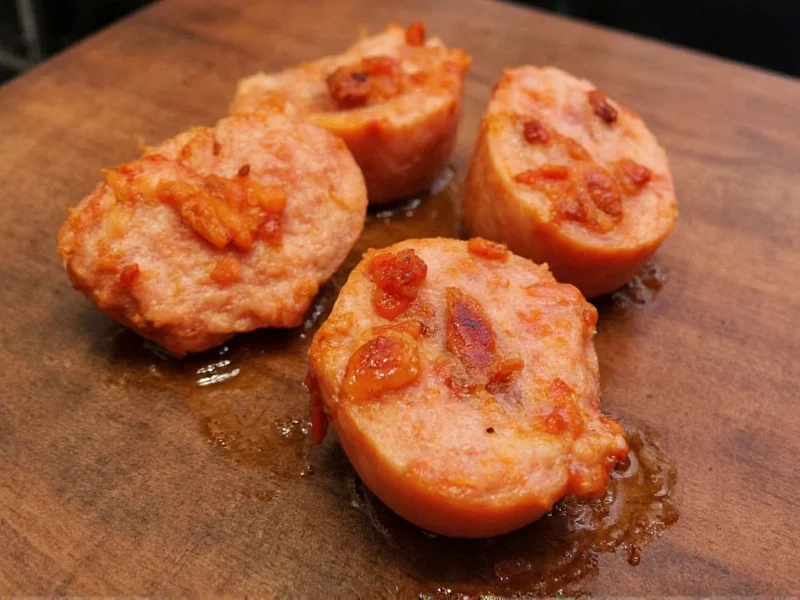The USDA recommends cooking chicken sausage to a safe internal temperature of 165°F (73.9°C). This precise temperature ensures all harmful bacteria like salmonella and campylobacter are eliminated while maintaining optimal texture and juiciness. Always verify with a reliable meat thermometer inserted into the thickest part of the sausage.
When preparing chicken sausage, achieving the correct internal temperature isn't just about taste—it's a critical food safety requirement. Unlike pork or beef sausages, poultry products require higher temperatures due to their susceptibility to dangerous pathogens. This comprehensive guide explains exactly how to cook chicken sausage safely while preserving its delicate flavor and texture.
Why 165°F Is Non-Negotiable for Chicken Sausage
Chicken sausage presents unique food safety challenges compared to other sausage varieties. The USDA's Food Safety and Inspection Service (FSIS) established 165°F as the minimum safe temperature for all poultry products because this threshold instantly destroys harmful bacteria including:
- Salmonella - Causes severe food poisoning with symptoms appearing 6-48 hours after consumption
- Staphylococcus aureus - Produces heat-stable toxins that survive cooking if bacteria were present beforehand
- Campylobacter - The leading cause of bacterial foodborne illness in the United States
Unlike whole chicken pieces where heat penetrates from the outside, sausages have ground meat throughout, creating more surface area for bacteria to thrive. The grinding process can distribute pathogens throughout the product, making thorough cooking essential.
Proper Thermometer Technique for Accurate Readings
Simply knowing the target temperature isn't enough—you must measure it correctly. Many home cooks make critical errors when checking chicken sausage temperature:
| Correct Technique | Common Mistake |
|---|---|
| Insert probe horizontally through side of sausage | Stabbing vertically from top (may hit casing but miss center) |
| Wait 15 seconds for reading to stabilize | Checking too quickly (thermometer hasn't equilibrated) |
| Test multiple sausages in the batch | Checking only one sausage (others may be undercooked) |
| Clean probe between readings | Cross-contaminating with bacteria from raw meat |
Digital instant-read thermometers provide the most reliable results for chicken sausage. Look for models with a thin probe (under 1/16 inch diameter) that can be inserted with minimal damage to the casing. Calibrate your thermometer monthly using the ice water (32°F) or boiling water (212°F) methods.
Visual Cues vs. Temperature Readings: Why Thermometers Win
Many home cooks rely on visual indicators like color change or firmness to determine chicken sausage doneness. This approach is dangerously unreliable:
- Color deception - Chicken sausage may appear fully cooked (no pink) well before reaching 165°F
- Texture confusion - Properly cooked chicken sausage should feel firm but slightly springy, not hard
- Smoke point interference - Cooking methods like grilling can create browned exteriors while interiors remain unsafe
USDA research shows poultry can maintain a pink hue even after reaching safe temperatures due to myoglobin reactions, especially in smoked or nitrate-treated products. The only reliable method for verifying chicken sausage internal temp is an accurate thermometer.
Carryover Cooking and Resting Period
Understanding carryover cooking is essential for perfect chicken sausage. When removed from heat, internal temperature continues rising 5-10°F during resting. Follow these guidelines:
- Remove sausages from heat source at 160°F
- Transfer to a warm plate (not cold surface that draws heat away)
- Cover loosely with foil to retain heat
- Allow 3-5 minutes resting time before serving
- Final temperature will stabilize at safe 165°F+
This resting period allows juices to redistribute, preventing dryness while ensuring food safety. Skipping this step often leads to overcooking as people leave sausages on heat longer trying to compensate for immediate temperature drop.
Troubleshooting Temperature Issues
Even with proper technique, challenges arise when cooking chicken sausage. Here's how to handle common scenarios:
Undercooked Sausage (Below 160°F)
If your chicken sausage hasn't reached at least 160°F, return to heat using these methods:
- For grilled sausage: Move to cooler part of grill to finish cooking slowly
- For pan-fried: Reduce heat and cover with lid to steam interior
- For baked: Lower oven temperature by 25°F and continue cooking
Overcooked Sausage (Above 175°F)
When chicken sausage exceeds 175°F, moisture loss becomes significant. Salvage overcooked sausage by:
- Slicing thinly and marinating in flavorful liquid
- Chopping for use in soups or stews where additional moisture helps
- Serving with sauce or gravy to compensate for dryness
Storage Guidelines for Cooked Chicken Sausage
Proper storage prevents bacterial growth after cooking. Follow these food safety protocols:
- Refrigerate within 2 hours of cooking (1 hour if ambient temperature exceeds 90°F)
- Cool quickly by placing in shallow containers (no more than 2 inches deep)
- Store at 40°F or below for up to 3-4 days
- Freeze at 0°F for up to 2-3 months
- Reheat to 165°F before serving leftovers
When reheating, use methods that preserve moisture like steaming or simmering in broth rather than dry-heat methods that exacerbate dryness in already-cooked poultry products.
Special Considerations for Different Cooking Methods
Each cooking method requires slight temperature technique adjustments:
Grilling Chicken Sausage
Manage flare-ups that cause exterior charring before interior reaches safe temperature. Use two-zone grilling with indirect heat for final cooking phase. Check temperature away from grill grates to avoid false high readings from radiant heat.
Baking Chicken Sausage
Oven cooking provides more even heat distribution. Place sausages on wire rack over baking sheet for air circulation. Rotate pan halfway through cooking for uniform results. Verify temperature in multiple spots as oven hot spots may create uneven cooking.
Sous Vide Chicken Sausage
For precision cooking enthusiasts, sous vide offers exact temperature control. Cook at 165°F for 1.5-2 hours, then quickly sear for texture. This method eliminates guesswork in achieving proper chicken sausage internal temp while maximizing juiciness.











 浙公网安备
33010002000092号
浙公网安备
33010002000092号 浙B2-20120091-4
浙B2-20120091-4